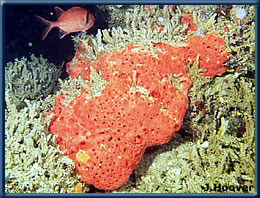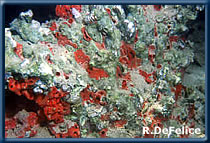

Haliclona caerulea

Gelliodes fibrosa

Suberites zeteki

Zygomycale parishii

Mycale armata
Mycale armata
 Orange
sponge
Orange
sponge
Phylum Porifera
Class Demospongiae
Order Poecilosclerida
Family Mycalidae
Description
Growth Morphology
Thickly encrusting, cushions to lobate-massive. Individuals can grow quite
large, up to 1 m diameter and 0.5m thick or larger.
Color
External color bright red-orange, internal same.
Texture and Surface Features
Sponge is firm, but compressible, tearing easily. Oscules are large and
conspicuous with raised membranous lip, scattered evenly over surface.
Surface is uneven, but smooth with large "keyhole" ostia. The
interior is cavernous, and often packed with small ophiuroids (Ophiactis
cf. savignyi).
 Spicules
Spicules
Megascleres: tylostyles
Microscleres: sigmas (2 sizes), palmate anisochelae (2 sizes), and raphides.
Habitat
In the Hawaiian Islands, M. armata is mainly
restricted to shallow-water fouling communities (i.e. pier pilings, floating
docks) of the major harbors on Oahu or associated disturbed habitats (i.e.
dredged channels and artificial lagoons). In Kaneohe Bay, M.
armata is found on patch reefs in southeast corner of the bay as
well as the fouling community on Coconut Island floating docks.
 Distribution
Distribution
Hawaiian Islands
Oahu - Pearl Harbor, Honolulu Harbor, Keehi Lagoon, Barber's Point Harbor,
and Kaneohe Bay.
Maui - Kahului Harbor.
Native Range
Australia (GBR); Torres Straits; Indo-Malay region
Present Distribution
Native range, and main Hawaiian Islands
Mechanism of Introduction
Unintentional introduction, most likely as fouling on ships' hull.
Impact
Fouling organism. Ecological impact unstudied, but observations suggests
competition for space with native sponge and coral species. In Kaneohe
Bay, this sponge appears to be overgrowing some coral on patch reefs,
especially Porites compressa.
Ecology
Feeding
Sponges are filter feeders, continuously circulating water through their
bodies. Microscopic food particles are removed from water by specialized
collar cells. Digestion is intracellular.
Reproduction
Like most sponges, M. armata is probably
capable of asexual reproduction by fragmentation. Details regarding sexual
reproduction of this species are unstudied.
Remarks
Mycale armata is considered to be a recently
unintentionally introduced species to Hawaii due to its sudden appearance
in the islands. This bright orange sponge is the largest, most conspicuous
sponge in the harbors of Oahu and in Kaneohe Bay, where the most extensive
surveys of sponges in the Hawaiian Islands were conducted. It is very
difficult to imagine this species could have been overlooked by these
experienced researchers.
Unlike the other alien sponges reported here, which appear to be relatively
benign introductions, this species may present a real threat to the lagoon-patch
reef communities of Kaneohe Bay (see Impact).
References
Bergquist, P. R. 1967. Additions to the sponge fauna of the Hawaiian Islands.
Micronesica. 3: 159-174.
de Laubenfels, M. W. 1950. The sponges of Kaneohe Bay, Oahu. Pac. Sci.
4(1): 3-36.
© 2002 Hawaii Biological Survey, Bishop Museum
contact